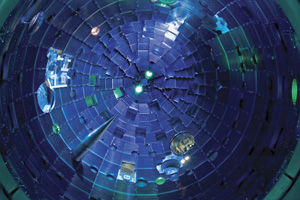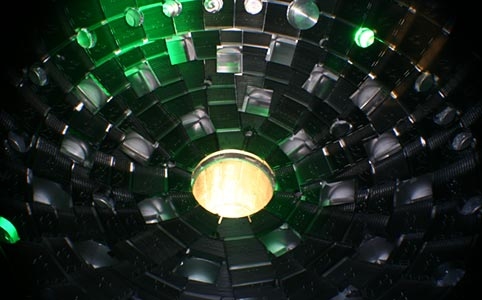DOE certifies NIF completion; laser operational
The Department of Energy announced Tuesday that the National Nuclear Security Administration (NNSA) has certified the completion of the historic effort to build the world's largest laser. The National Ignition Facility is expected to allow scientists to achieve fusion ignition in the laboratory, obtaining more energy from the target than is provided by the laser.
The completion of NIF opens the door to scientific advancement and discovery that promises to enhance national security, could help break America's dependence on foreign oil, and will lead to new breakthroughs in the world of astrophysics.
"Completion of the National Ignition Facility is a true milestone that will make America safer and more energy independent by opening new avenues of scientific advancement and discovery," NNSA Administrator Thomas D'Agostino said. "NIF will be a cornerstone of a critical national security mission, ensuring the continuing reliability of the U.S. nuclear stockpile without underground nuclear testing, while also providing a path to explore the frontiers of basic science, and potential technologies for energy independence."
NIF is a critical part of NNSA's mission to maintain the safety and reliability of the nation's nuclear deterrent without conducting nuclear tests. The United States has not deployed a new nuclear weapon in more than 20 years, nor conducted an underground nuclear test since 1992. Instead, scientists at NNSA maintain the warheads in the stockpile well beyond their original life by using sophisticated supercomputers and facilities that test the safety, security and reliability of U.S. weapons.
With NIF, scientists will be able to evaluate key scientific assumptions in current computer models, obtain previously unavailable data on how materials behave at temperatures and pressures like those in the center of a star and help validate NNSA's supercomputer simulations by comparing code predictions against observations from laboratory experiments.
Because of its groundbreaking advance in technology, NIF also has the potential to produce breakthroughs in fields beyond national security. It may help advance fusion energy technology, which could be an element of making the United States energy independent. It also could help scientists better understand the makeup of stars.
The stadium-sized NIF is capable of focusing all of its 192 individual beams, each about 40 centimeters square, into a spot about one-half millimeter in diameter at the center of its 10–meter diameter target chamber. NIF has the ability to deliver large amounts of energy with extreme precision in billionths of a second.
NIF has already produced historic scientific advances. In March, NIF became the first fusion laser in the world to break the megajoule barrier by delivering 1.1 million joules (one joule is the energy required to lift a small apple one meter against the Earth's gravity) of ultraviolet energy to the center of its ten-meter-diameter target chamber — more than 25 times more energy than the previous record-holder.






